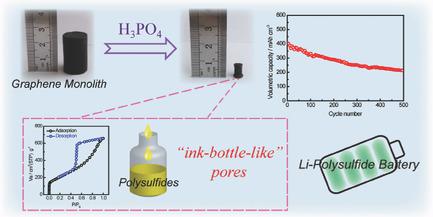当前位置:
X-MOL 学术
›
Adv. Energy Mater.
›
论文详情
Our official English website, www.x-mol.net, welcomes your
feedback! (Note: you will need to create a separate account there.)
Dense Graphene Monolith for High Volumetric Energy Density Li–S Batteries
Advanced Energy Materials ( IF 24.4 ) Pub Date : 2018-03-12 , DOI: 10.1002/aenm.201703438 Huan Li 1 , Ying Tao 1 , Chen Zhang 1 , Donghai Liu 1 , Jiayan Luo 1 , Weichao Fan 1 , Yue Xu 1 , Youzhi Li 1 , Conghui You 2 , Zheng-Ze Pan 2 , Mingchun Ye 1 , Zhengyu Chen 1 , Zhang Dong 1 , Da-Wei Wang 3 , Feiyu Kang 2 , Jun Lu 4 , Quan-Hong Yang 1, 5
Advanced Energy Materials ( IF 24.4 ) Pub Date : 2018-03-12 , DOI: 10.1002/aenm.201703438 Huan Li 1 , Ying Tao 1 , Chen Zhang 1 , Donghai Liu 1 , Jiayan Luo 1 , Weichao Fan 1 , Yue Xu 1 , Youzhi Li 1 , Conghui You 2 , Zheng-Ze Pan 2 , Mingchun Ye 1 , Zhengyu Chen 1 , Zhang Dong 1 , Da-Wei Wang 3 , Feiyu Kang 2 , Jun Lu 4 , Quan-Hong Yang 1, 5
Affiliation

|
Despite the outstanding gravimetric performance of lithium–sulfur (Li–S) batteries, their practical volumetric energy density is normally lower than that of lithium‐ion batteries, mainly due to the low density of nanostructured sulfur as well as the porous carbon hosts. Here, a novel approach is developed to fabricate high‐density graphene bulk materials with “ink‐bottle‐like” mesopores by phosphoric acid (H3PO4) activation. These pores can effectively confine the polysulfides due to their unique structure with a wide body and narrow neck, which shows only a 0.05% capacity fade per cycle for 500 cycles (75% capacity retention) for accommodating polysulfides. With a density of 1.16 g cm−3, a hybrid cathode containing 54 wt% sulfur delivers a high volumetric capacity of 653 mA h cm−3. As a result, a device‐level volumetric energy density as high as 408 W h L−1 is achieved with a cathode thickness of 100 µm. This is a periodic yet practical advance to improve the volumetric performance of Li–S batteries from a device perspective. This work suggests a design principle for the real use Li–S batteries although there is a long way ahead to bridge the gap between Li–S batteries and Li–ion batteries in volumetric performance.
中文翻译:

用于高体积能量密度Li–S电池的致密石墨烯整料
尽管锂硫(Li–S)电池具有出色的重量分析性能,但它们的实际体积能量密度通常低于锂离子电池,主要是由于纳米结构硫和多孔碳主体的密度较低。在这里,开发了一种新颖的方法来通过磷酸(H 3 PO 4)活化来制造具有“瓶状”中孔的高密度石墨烯散装材料。这些孔由于具有宽阔的身体和狭窄的颈部的独特结构而可以有效地限制多硫化物,在容纳多硫化物的500个循环中,每个循环仅显示0.05%的容量衰减(75%的容量保持率)。密度为1.16 g cm -3,包含54 wt%硫的混合阴极可提供653 mA h cm -3的高体积容量。结果,在阴极厚度为100 µm的情况下,可以实现高达408 W h L -1的器件级体积能量密度。从设备的角度来看,这是一个定期但实用的进步,可以改善Li-S电池的容量性能。这项工作为实际使用的Li-S电池提出了一种设计原则,尽管要弥合Li-S电池和Li-ion电池在体积性能方面的差距还有很长的路要走。
更新日期:2018-03-12
中文翻译:

用于高体积能量密度Li–S电池的致密石墨烯整料
尽管锂硫(Li–S)电池具有出色的重量分析性能,但它们的实际体积能量密度通常低于锂离子电池,主要是由于纳米结构硫和多孔碳主体的密度较低。在这里,开发了一种新颖的方法来通过磷酸(H 3 PO 4)活化来制造具有“瓶状”中孔的高密度石墨烯散装材料。这些孔由于具有宽阔的身体和狭窄的颈部的独特结构而可以有效地限制多硫化物,在容纳多硫化物的500个循环中,每个循环仅显示0.05%的容量衰减(75%的容量保持率)。密度为1.16 g cm -3,包含54 wt%硫的混合阴极可提供653 mA h cm -3的高体积容量。结果,在阴极厚度为100 µm的情况下,可以实现高达408 W h L -1的器件级体积能量密度。从设备的角度来看,这是一个定期但实用的进步,可以改善Li-S电池的容量性能。这项工作为实际使用的Li-S电池提出了一种设计原则,尽管要弥合Li-S电池和Li-ion电池在体积性能方面的差距还有很长的路要走。











































 京公网安备 11010802027423号
京公网安备 11010802027423号